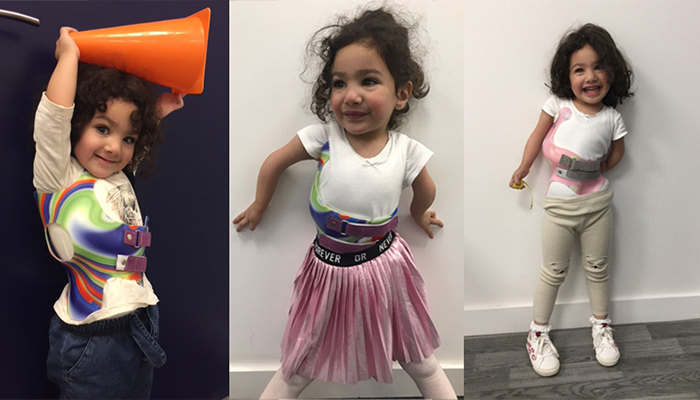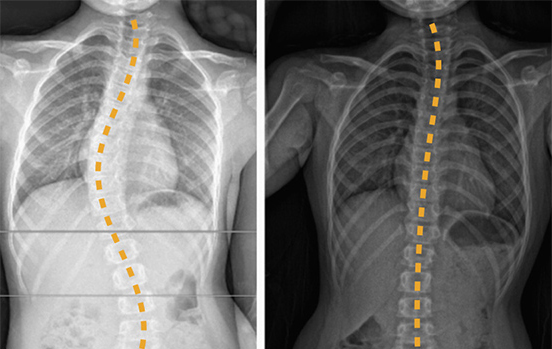Juvenile idiopathic scoliosis is typically defined as scoliosis that is first diagnosed between the ages of 4 and 10. This category comprises about 10% to 15% of all idiopathic scoliosis in children.
At the younger end of the spectrum, boys are affected slightly more than girls and the curve is often left-sided. Towards the upper end of the age spectrum, the condition is more prevalent in girls and the curve tends to be right-sided.
Children with juvenile scoliosis generally have a high risk of progression of their curve. Seven out of 10 children with this condition will worsen and require active treatment with scoliosis bracing.
Note, juvenile idiopathic scoliosis is different to infantile idiopathic scoliosis, which is diagnosed in children between birth and 3 years of age. Infantile scoliosis accounts for fewer than 1% of all scoliosis cases in children.

One of our juvenile scoliosis patients was two years old when we first braced her. Her primary curve reduced from 44 to 27 degrees in 4 months. From left: first brace fitting, review of first brace and second brace fitting.
In juvenile scoliosis, where there are curves between 10 and 25 degrees, Schroth physiotherapy may be able to make some corrections or control the curve. However, once the curve is greater than 25 degrees it is usually too large for physiotherapy alone to manage and physio in conjunction with scoliosis bracing is recommended.
As with adolescent scoliosis, we treat juvenile scoliosis with our own bespoke version of the Cheneau brace, the LOC Scoliosis Brace. which takes a three-dimensional approach to the treatment of scoliosis combined with Schroth-based physiotherapy principles.
Depending on the age of the child, parents may need to help them follow their recommended postural activities. Once correction of the curve has been achieved, scoliosis bracing may be discontinued for one or more years with a return to observation. As the child begins an adolescent growth spurt, it is likely that they will need to be re-braced to maintain the previously achieved correction of the curve.

These scans are from a three-year-old boy with juvenile idiopathic scoliosis. He first came to us with a single thoracic curve and was hypermobile. He was fitted with a bespoke Cheneau-Gensingen brace and had custom foot orthotics fitted to aid with his hypermobile pes planus (flat feet). Overall, he responded very well to bracing.

The LOC Scoliosis Brace takes a three-dimensional approach to scoliosis treatment. This type of bracing is regarded by many scoliosis clinics around the world as the preferred alternative to surgery, since it has been proven to reduce Cobb angles and improve posture.

Our bespoke scoliosis treatment can be combined with a comprehensive physiotherapy programme that adheres to the principles of the world-renowned Schroth treatment.
Our treatment package price includes all reviews and on-site adjustments of the brace by our certified orthotists.

There may be cancellations or delays to your child’s spinal surgery for several reasons. At LOC, we are here to assist where possible. Using our corrective LOC Scoliosis Brace, we can halt the curve's progression, balance posture and reduce any back pain.

“It’s life-changing, my swimming coach has even remarked what a difference my treatment has made" Read how pectus bracing treatment helped to correct Aris' complex chest deformity, involving a combination of pectus excavatum, pectus carinatum and rib flaring.

Cerebral palsy patient Lucas sees significant improvement in his walking after only six months in his new custom Ankle Foot Orthoses (AFOs), designed by Professor Saeed Forghany in our Manchester clinic. Hear how a detailed gait analysis and bespoke AFOs significantly improved Lucas's gait and comfort.

Freddie’s positional plagiocephaly was treated successfully with the LOCBand Lite, going from 11mm to 2mm after four months in his helmet.

Adult club foot (talipes) patient Natasha says, "I cannot stress how amazing my AFOs are and how they have changed so much for me. The support they give me allows me to walk without crutches outside the house for the first time in over fifteen years."

Diagnosed with adolescent idiopathic scoliosis at 14 years old, Polly and mum Zoe looked to the LOC Scoliosis Brace to help her curve and avoid surgery at a later date.

LOC opens its first clinic in Northern Ireland, LOC Belfast, offer non-surgical orthotic treatment for scoliosis, pectus carinatum and pectus excavatum. Here, we will also be able to provide orthotic treatments for a range of adult and paediatric lower limb conditions including cerebral palsy, spina bifida, hypermobility, stroke, post-polio syndrome, and multiple sclerosis.

Mum Natalie shares her experience of having both her identical twins diagnosed with craniosynostosis. Ella and Nina had surgery at Great Ormond Street Hospital before going through cranial remoulding therapy at the London Orthotic Consultancy.

See how a thorough gait analysis and a correctly-fitted, bespoke Reciprocating Gait Orthosis (RGO) helped Ted, a spinal surgery and cancer survivor, improve his rehabilitation and mobility goals, getting him back on his feet again.